Last updated: January 27, 2024
Article
50 Nifty Finds #41: What in the Blazers?
The green pants and jacket, gray shirt, badge, and broad-brimmed flat hat are the widely recognized symbols of the National Park Service (NPS) ranger. For a brief period in the 1970s, an attempt was made to supplement—if not supplant—the public’s image of the park ranger. Was the NPS blazer uniform just a fashion fad or something more?
An "Urban" Uniform?
With a few modifications over time, the NPS standard uniform has represented the park ranger image since 1920. On March 10, 1972, a new optional men’s uniform was approved by NPS Director George B. Hartzog Jr. No documentation has been found to suggest that employees were notified of the new uniform prior to July 10, 1972. On that date, however, a question was posed in the NPS Newsletter: “I’ve heard there is now a new NPS optional men’s uniform. Could you please tell me more about it?” This possibly contrived letter to the editor appears to be the uniform’s formal debut.
The response was quick to point out that the new uniform didn’t replace the standard uniform but,
[it] will be worn as an alternative to it, or in some cases in lieu of it, by employees of [the Washington Office], regional offices, and service centers who frequently represent the Service in external affairs, events, or meetings, and by park employees in interpretation, administration, or other positions which involve frequent contact with the visiting public, business, civic or private organizations. Field directors and superintendents will have final determination and responsibility for who will wear this optional uniform.
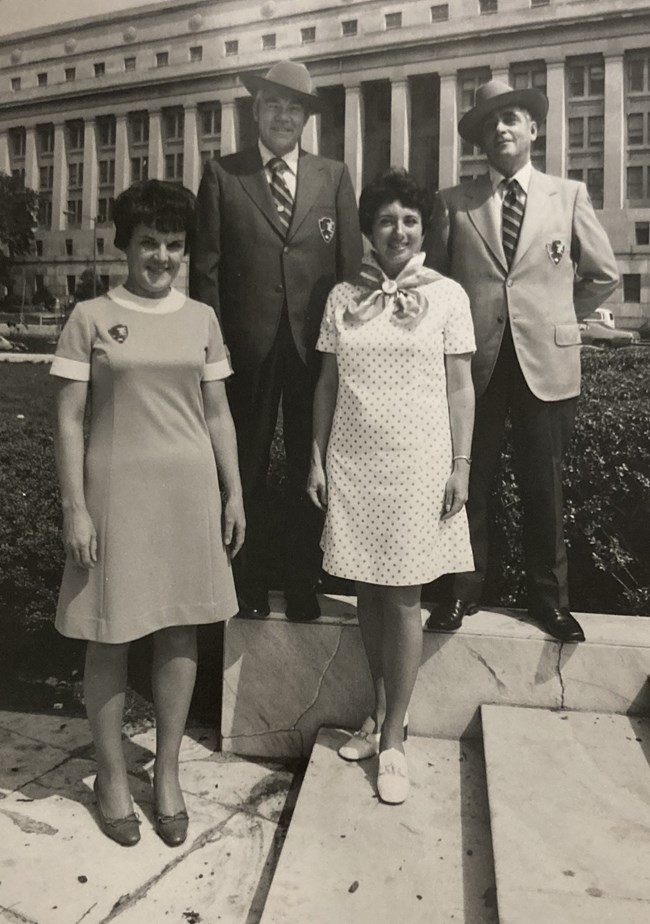
It was a stark change in color and design from the standard “green and gray” ranger uniform, consisting of:
-
Blazers (camel or leaf green in color)
-
Slacks (rust brown color)
-
Long- or short-sleeved shirts (canary yellow)
-
Tie (green with gold and brown stripes)
-
Belt (brown)
-
Shoes (cordovan plain toe or chukka boots)
-
Socks (dark brown)
-
Stetson-style hat (“Open Road” type in the palomino color)
The NPS arrowhead patch was sewn on the left side of the blazer, just beneath the pocket opening. Unlike the traditional arrowhead with a brown thread border, the patches on the camel and leaf green blazers were finished in gold.

According to the July 1972 article, all the field directors participated in decisions on colors and fabrics for the uniform. The final selections were made by Associate Deputy Director Joe Rumburg and Procurement Analyst Ray O’Dell at a meeting with the major uniform suppliers held in Washington, DC, on March 1, “according to guidelines set by the director and the field directors and by the material available” to the suppliers. This approach to uniform design was unusual because it didn’t come from an NPS uniform committee made up of field and central office staff.
Interestingly there were no letters to the editor printed in the NPS Newsletter in response to the new optional uniform. Given its radical departure from the standard NPS uniform, a tradition of field staff voicing opinions for or against changes to the uniform, and contemporary letters to the editor about uniform and image issues (e.g., women’s uniforms, replacing ties with cravats, facial hair, etc.), the lack of commentary on this change is significant. Likely explanations are that either letters were sent and not printed, the “top-down” approach for developing and rolling out the uniform discouraged feedback, or so few employees were affected at the field level that it wasn’t worth voicing an opinion about.
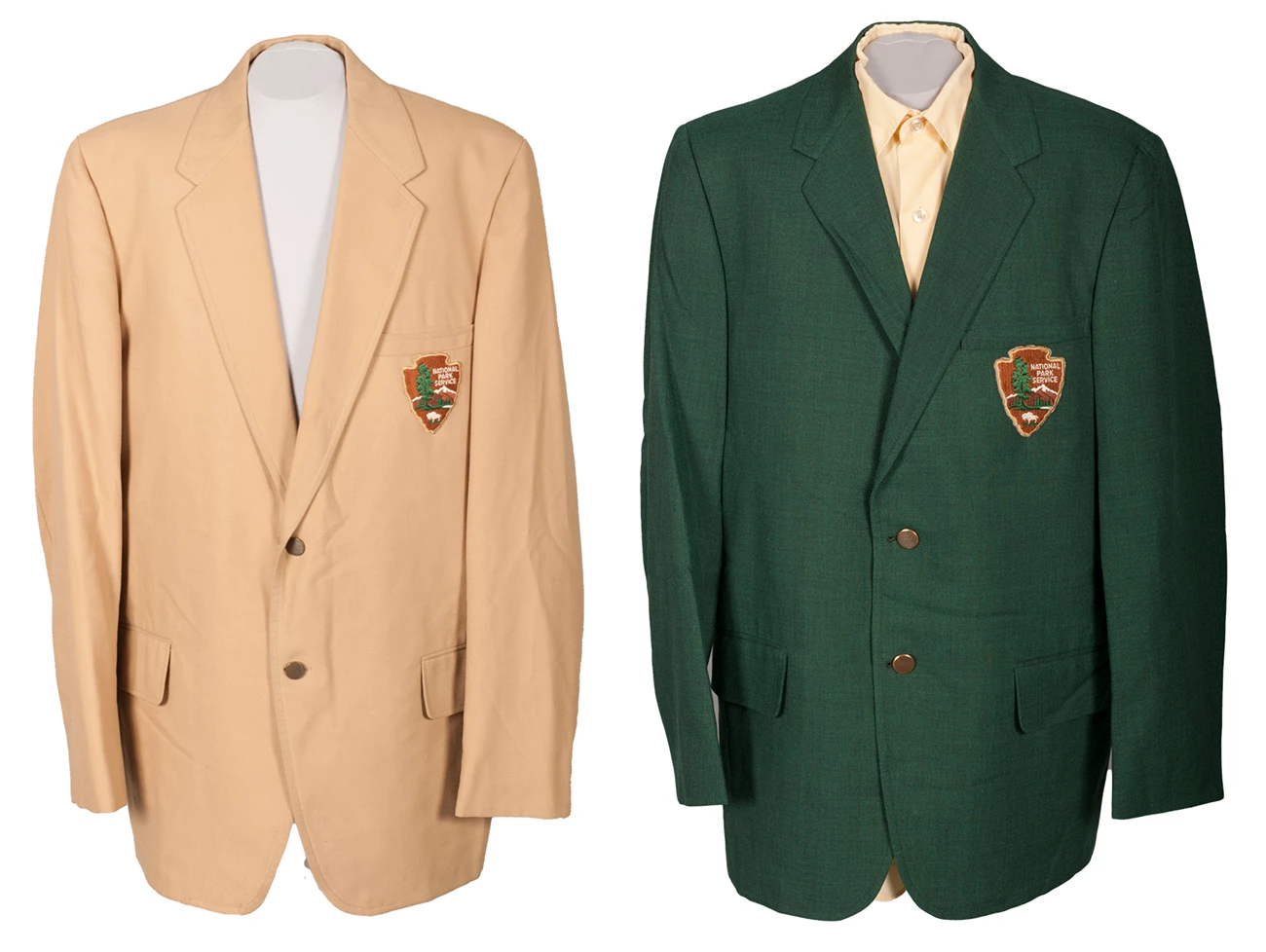
People, Not Place
Although R. Bryce Workman’s review of NPS men’s uniforms ended in 1970, he briefly discusses this uniform in his volume about women’s uniforms. He suggests that the optional men’s uniform was created because 1972 was the centennial year, but there is little to support that conclusion. The official kickoff for the centennial celebration was March 1—nine days before Hartzog approved the uniform. Major uniform suppliers such as Alvord and Ferguson and Gregorys had already issued their annual catalogs and order forms for the year without the optional uniform. By the time the field was informed via the NPS Newsletter article in July, the year was half over. The delay in announcing the new uniform was probably to provide the manufacturers time to make and/or stock them ahead of receiving orders. If the centennial was the reason the uniform was created, it was arguably not very successful.

The July 1972 article notes that “Director Hartzog hopes to see as many employees as possible wearing it during the centennial year and thereafter” (emphasis added), making it clear that it was intended to be more than just an optional uniform for the centennial year. George B. Hartzog III recalls his father wearing the blazer and slacks even though it wasn’t among Director Hartzog’s uniforms donated to the NPS History Collection. Photographs of him wearing it haven’t been found.
Workman dubbed this new look the “urban uniform.” Interestingly that term is not found in the available documentation. He may have been inspired by the terms used in horse patrol uniforms that distinguished between urban and backcountry functions. By describing it as such, however, Workman identifies location as the significant factor in its use, incorrectly suggesting that it would only be worn in cities. In fact, public contact was the primary reason to wear this new uniform.
Although little has been found about the rationale for creating this uniform, issues and trends inside the NPS and broader American society may provide insights into some of the factors influencing its use.
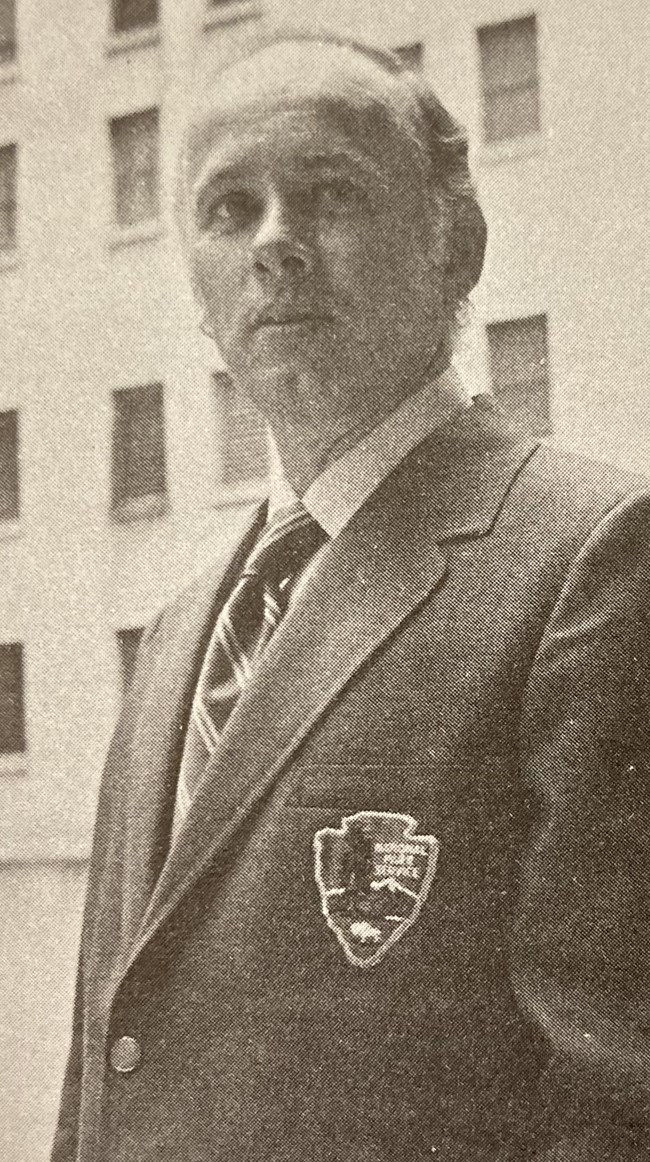
Career Apparel
In the early 1970s many American industries were switching from uniforms to “career apparel.” As one 1972 newspaper article described it, the trend was “tied in with the modern efforts at image-making and instant identification. Intended to help the growing number of service-oriented businesses to ‘look their part,’ career apparel has taken its lead from the airlines, which long ago created fashionable and functional clothing.”
Interestingly Fashionaire, the women’s division of Hart, Shaffner, and Marx—the creator of the 1970 NPS women’s uniform and the centennial dress described below—was an early advocate of career apparel. The direct connection between this trend and the blazer uniform can been seen in Alvord and Ferguson’s January 1974 catalog and order form that places the blazer uniform under a “career apparel” heading.
In addition to over 50 years of uniform history that established a distinctive park ranger image embraced by generations of NPS staff and the visiting public, there was a practical barrier to this uniform being widely adopted for public contact: employees who wished to wear it had to purchase it at their own expense. Depending upon the options selected, it cost $115–$123 without shoes. This would have been a significant investment for interpretive rangers who already had the standard uniform. It makes sense, then, that available photographs show superintendents from New York to Yosemite and regional directors and other upper-level managers wearing the uniform; they earned more and would be expected to lead by example to implement the director’s initiative.
Although Director Hartzog embraced modern design aesthetics as part of his many initiatives, it's unlikely that national fashion trends would have been the primary reason the NPS created a new uniform.
A Trial Run?
In addition to men in the headquarters, service centers, and regional offices, the optional uniform was to be worn “by park employees in interpretation, administration, or other positions which involve frequent contact with the visiting public, business, civic or private organizations.” Historically the fact that interpreters were also to wear it has been overlooked—and it raises an intriguing question. Was this optional uniform a trial run to determine how the public (and perhaps more importantly) NPS staff would react to a radical change in uniforms for interpretive positions?
Following the Stoneman Meadow riot at Yosemite National Park in July 1970 and increases in crime and drug use in national parks, Director Hartzog convinced Congress to increase NPS funding. In 1971 he created a new law enforcement program in the Washington Office, expanded US Park Police (USPP) operations in Washington, DC, and added new USPP field offices in New York and San Francisco. He also began a law enforcement training program. At the same time, Hartzog emphasized expanding interpretive programs, including environmental education and living history, and making parks relevant to urban communities.
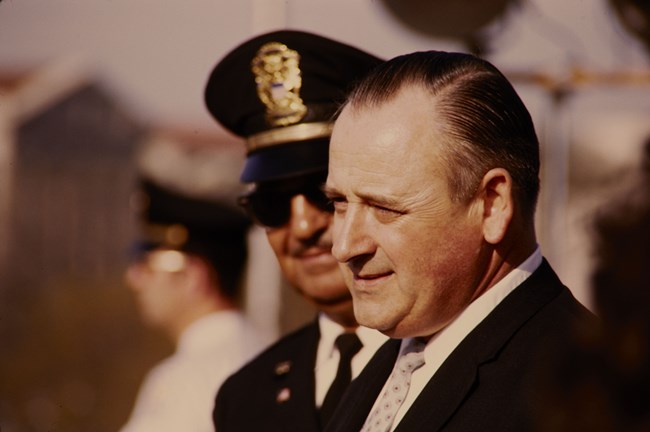
Following the civil unrest of the 1960s and early 1970s many police departments around the country switched from traditional law enforcement uniforms to blazers and trousers to “soften” their images and foster better cooperation between residents and officers. In 1972 dozens of police departments in states across the country were trialing these new uniforms. As the Richmond, Indiana, police force noted, its new blazer uniform was “intended primarily for speaking engagements and other public appearances when the wearer wishes to convey a soft-line public service image, rather than the hardline police image.” The Lancaster, Pennsylvania, police chief stated, “We feel the new uniforms will be less abrasive and command more respect.” Few of these efforts went beyond short-term trial runs.
Seeing the broader trend to distinguish among law enforcement officers and department goals, could Hartzog’s optional blazer uniform been an effort to support his educational goals by making the interpretive rangers visually distinct from law enforcement rangers? As law enforcement offices around the country hoped, would the blazers and slacks make interpreters more approachable to audiences who distrusted law enforcement? While hardly conclusive, it’s notable that the official NPS ranger badge—the symbol of legal authority—was not approved for use on the blazer uniform.
Without further documentation, this remains speculative. However, as director, Hartzog wasn’t afraid to challenge NPS traditions. It’s not unreasonable, therefore, to see the optional blazer uniform as a trial run for a different, more approachable public face of the NPS. Given reactions to his previous attempts to change NPS culture and identity symbols, a softer launch to gage reactions would have been savvy. Like his earlier changes to the ranger badge and plan to remove the NPS arrowhead from uniforms, however, the blazer uniform doesn’t seem to have been widely embraced by field staff.
Hartzog, a likely champion of the blazer uniform, left his position on December 31, 1972, but it remained part of uniform regulations for another couple of years at least.
The Blazer Uniform
The optional uniform continued as an official NPS uniform after the 1972 national parks centennial. The February 1974 Uniform Standards note,
The blazer and traditional uniform provide versatility of wear by management personnel as well as field employees having contact with park visitors. The blazer uniform shall be worn when on duty in or out of the parks as deemed appropriate by the park superintendent. This will be the principal uniform identification of regional and Washington Office personnel on public contact assignments or where identification of the Service is necessary. The arrowhead symbol will be sewn to the left breast pocket.

Although the standards report in a section on uniform history that this optional uniform was adopted in 1971, that appears to be a typo. The 1971 men’s uniform standards do not include this uniform and the NPS Newsletter article clearly states that Director Hartzog approved it on March 10, 1972.
A few notable changes were made in 1974. The shirt is described as gold rather than canary yellow. The necktie is gold and green striped, without the brown. A gold nametag and gold arrowhead tie tack have been added. The "Open Road"-style, palomino-colored Stetson was still optional, as was a small NPS patch sewn on the left breast pocket of the shirt.
It’s not clear exactly when the blazer uniform option was removed from the NPS uniform standards. Alvord and Ferguson’s 1973 catalog only offered the blazer in limited sizes. By 1974 they had reduced them in price by up to 40 percent. Perhaps the writing was on the wall for the blazer uniform. The April 21, 1975, National Park Service Newsletter features a photograph of Carlos Goff, acting chief of maintenance at the John F. Kennedy Center for the Performing Arts, wearing the uniform, suggesting it was still authorized. By 1976, however, the uniform standards don’t mention the blazer uniform at all (even to officially state it is no longer an option).
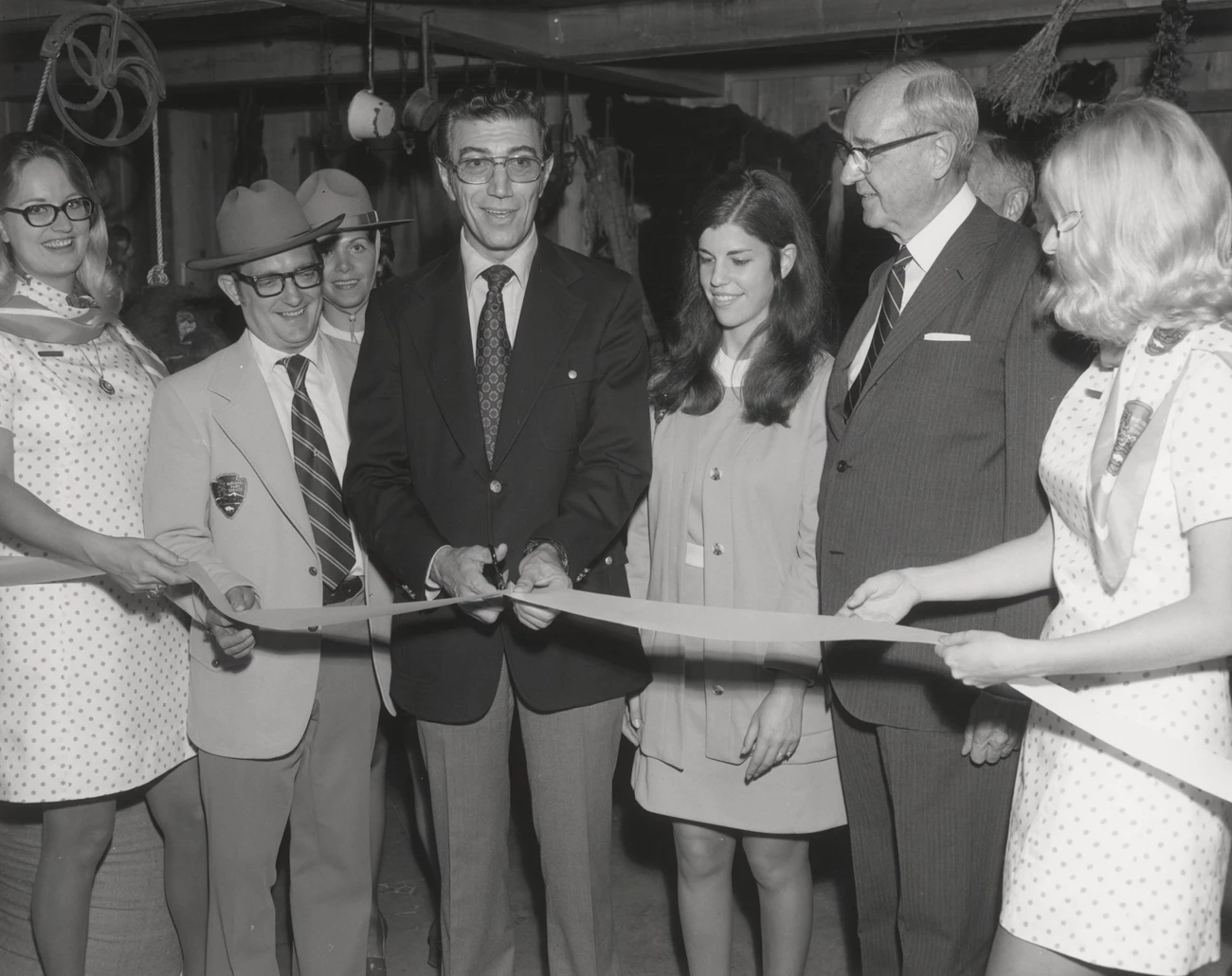
The Centennial Dress
The photograph in the July 1972 NPS Newsletter, shown earlier, that debuted the optional blazer uniform included Carol Scanlon modeling the centennial dress. This photo led Workman to the incorrect conclusion that the dress, like the blazer uniform, was authorized on March 20, 1972, and that it “served as a companion piece for the men’s optional urban dress.” In fact, the centennial dress debuted in January that year—which explains why the dress is only mentioned in the photo caption and not in the article itself as Workman points out.
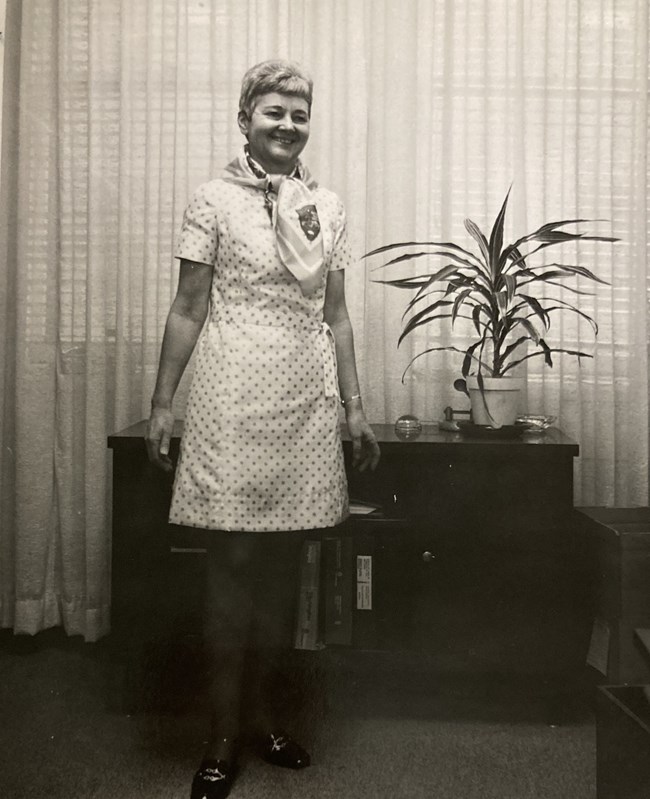
The optional dress could be worn by NPS women at any centennial function. It was a lined, A-line dress created in a white fabric with small orange polka dots. The pattern matched the NPS scarf from the December 1970 uniform standards that could be worn with it. A belt, made from the same orange polka dot fabric, was optional.
Although the dress was officially authorized, the NPS arrowhead patch, worn on the women’s beige uniforms of the time, wasn’t part of it. The NPS Women’s Organization and the NPS Employee & Alumni Association coordinated and promoted its sales. Women had to pay for it themselves, ordering directly from Fashionaire in Chicago, Illinois. The dress cost $32 and the scarf $8.50.
No sales figures for the dress have been found. The handful of photographs of women wearing the dress suggest it might not have been as popular as expected. Although the blazer uniform continued for at least a couple of years, the centennial dress was authorized only for 1972. Perhaps it’s not surprising then that no surviving examples are known. If you have one, please consider contacting the archivist.
Sources:
--. (1969, July 30). “Uniforms Change.” Irving Daily News (Irving, Texas), p. 1.
--. (1969, August 21). “Uniform Tradition Abandoned in MP.” Redwood City Tribune (Redwood City, California), p. 2.
--. (1969, September 29). “Seattle Cops Swap Brass for Blazers.” News-Press (Fort Meyers, Florida), p. 24.
--. (1972, July 10). “Feedback: New Optional Uniform.” NPS Newsletter, Vol 7, No 13. NPS History Collection (HFCA 1645), Harpers Ferry, WV.
--. (1972, June 11). “New Blue Blazer Uniforms Worn by City Police Speakers.” Palladium-Item (Richmond, Indiana), p. 29.
--. (1972, November 29). “Police Uniform Change Not Popular.” The Newark Advocate (Newark, Ohio), p. 1.
Alvitre, Myna. (1972, October 5). “King City Police Officers Adopt New Look, Techniques.” The Californian (Salinas, California), p. 15.
Assembled Historic Records of the NPS (HFCA 1645). NPS History Collection, Harpers Ferry, WV.
Hartzog, George B. III. (2023, December 28). Pers. Comm. with Nancy Russell, archivist, NPS History Collection, Harpers Ferry, WV.
NPS Historic Photograph Collection (HFCA 1607). NPS History Collection, Harpers Ferry, WV.
Phillips, Nancy. (1972, July 10). “In Business ‘Career Apparel’ Booms.” The Austin American (Austin, Texas), p. 14.
Roberts, Chris. (1972, November 8). “Pennsylvania Police Seeking New Image.” Athol Daily News (Athol, Massachusetts), p. 2.
Scanlon, Carole. (1972, January 24). “Centennial Women’s Program.” NPS Newsletter, Vol 7, No 1. NPS History Collection (HFCA 1645), Harpers Ferry, WV.
Sellars, Richard West. (1997). Preserving Nature in the National Parks: A History. Yale University Press, New Haven, Connecticut. Available online at https://www.nps.gov/parkhistory/online_books/sellars/index.htm
Workman, R. Bryce. (1998). Breeches, Blouses, and Skirts, 1918-1991. National Park Service Uniforms series #4. National Park Service, Harpers Ferry, WV. Available online at https://www.nps.gov/subjects/hfc/upload/No-4_Breeches-Blouses-and-Skirts.pdf
Workman, R. Bryce. (1998). The Developing Years, 1932-1970. National Park Service Uniforms series #5. National Park Service, Harpers Ferry, WV. Available online at https://www.nps.gov/subjects/hfc/upload/No-5-National-Park-Service-Uniforms-The-Developing-Years-1932-1970-Table-of-Contents.pdf
